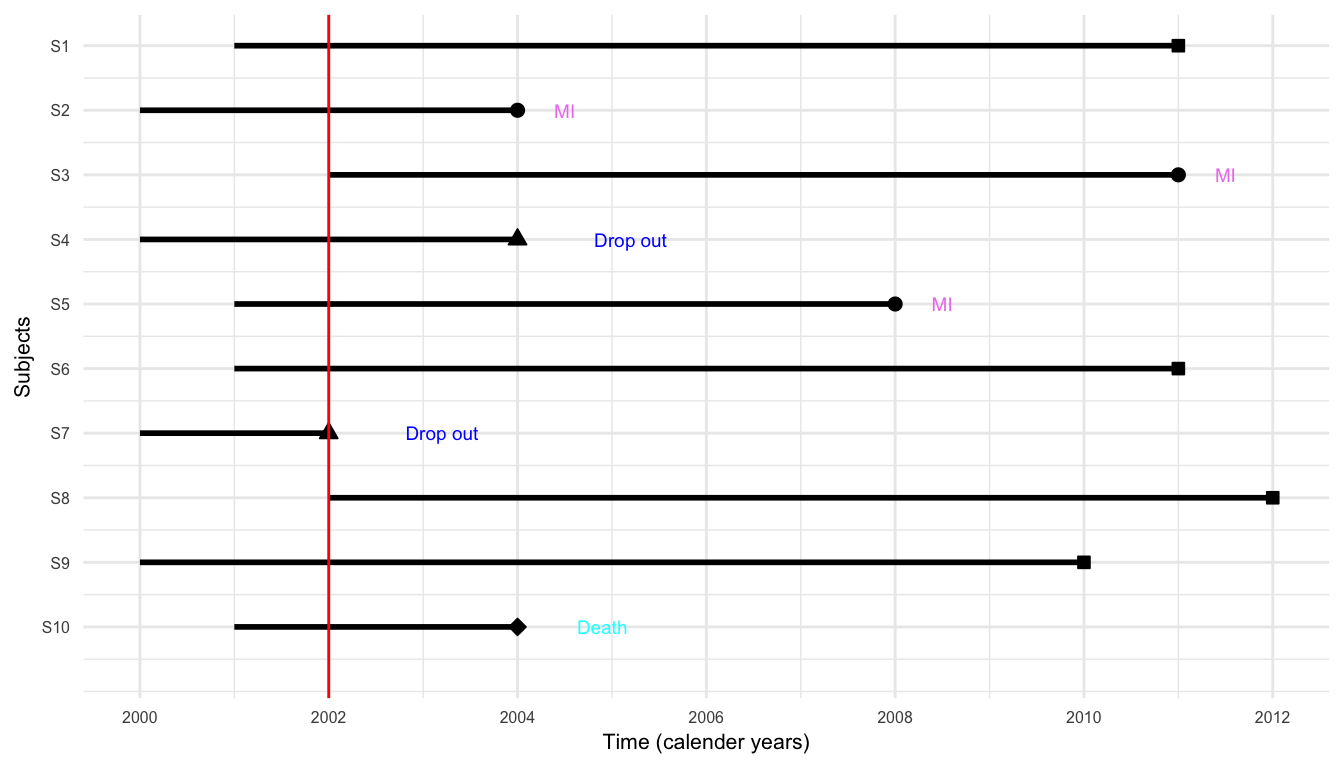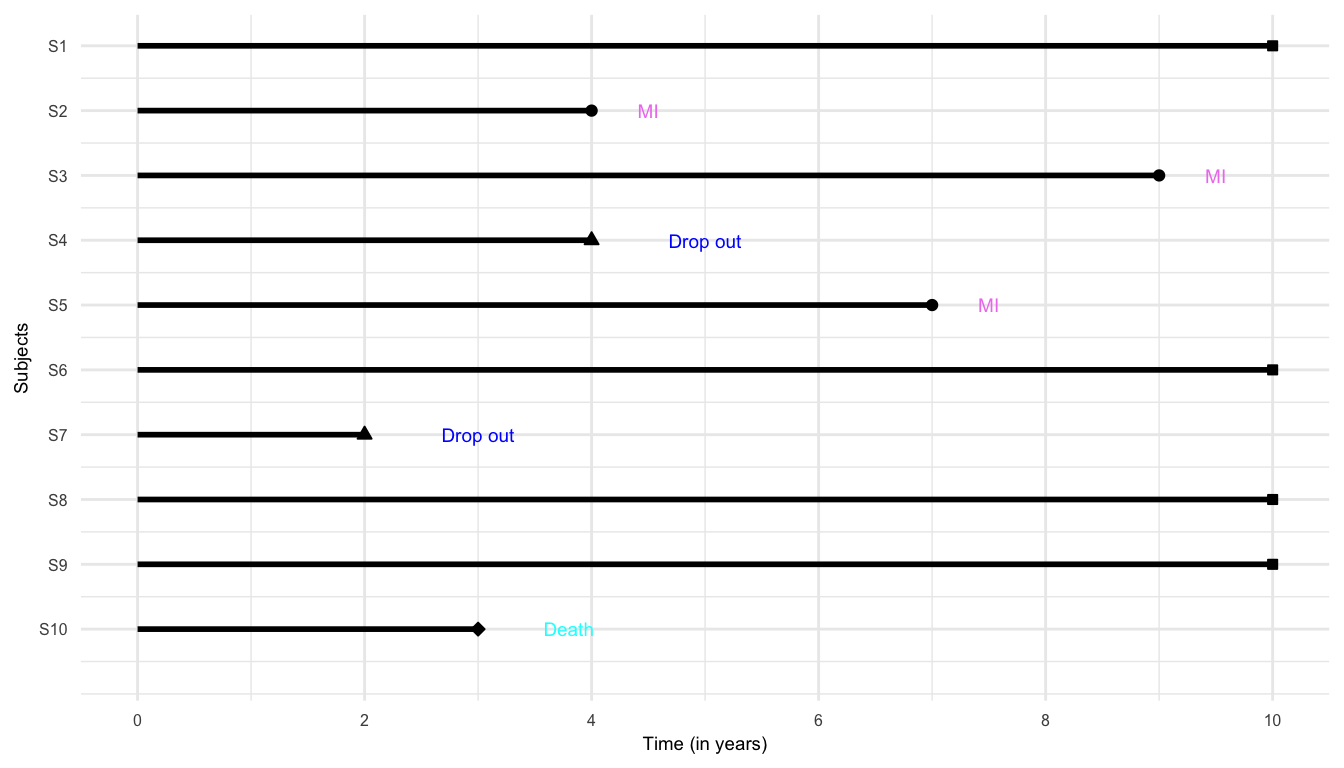
Chapter 2
(AST405) Lifetime data analysis
2 Observed Schemes, Censoring, and Likelihood
2.1 Introduction
Preliminary discussion of likelihood;
Suppose that the probability distribution of potentially observable data in a study specified up to the parameter vector
-
A likelihood function for
Data
Asymptotic results and large sample methods
Assume that the data consist of a random sample
The likelihood function for
If
-
Let
In most simple settings
It is often convenient to work with the log-likelihood function, which is also maximized at
-
The m.l.e.
-
Score vector
-
Under mild regularity conditions
Optimization methods for maximum likelihood
- Maximum likelihood estimator
There are different numerical approaches for optimizing the multiparameter log-likelihood function
Many likelihood functions have a unique maximum at
Numerical approaches involve a starting point
-
Three types of optimization methods are available in statistical software
Methods that do not use derivatives (e.g., simplex algorithm, such as Nelder-Mead method)
Methods that use only first derivates
-
Methods that use both first derivative
-
-
-
Newton-Raphson method is commonly used for optimizing
-
-
- Using Taylor series expansion, expanding
- Then
- Then
In many situations, finding the maximum likelihood estimator may be challenging, e.g. it may be on the boundary of
Likelihood function may also possess multiple stationary points, and optimization techniques are designed to obtain local maxima, so it may not converge to global maxima
It is important to understand the shape of
Example 2.1.1
Suppose that the lifetimes of individuals in some population follow a distribution with density function
In format of Eq. 2.1.1, Data =
Parametric approach
Assume that
Likelihood function
The maximum likelihood estimator
For example, if
Nonparametric approach
Assume
-
The model parameters are
- Restrictions:
- Restrictions:
-
The maximum likelihood estimators can be obtained by maximizing the corresponding likelihood function
-
-
-
Estimate of the distribution function
-
-
Likelihood for a truncated sample
-
Suppose that
- No information is available for those whose lifetimes are greater than one year
The likelihood function for this truncated sample is given by
Likelihood based inferences
Score test
Score vector
Under the null hypothesis
The statistic
Wald test
The m.l.e.
In other words,
Under
Since
Likelihood ratio test
- Under
2.2 Right censoring and maximum likelihood
Right censoring and maximum likelihood
For right censored data, only the lower bounds on lifetime are available for some individuals
Right censored lifetimes are observed for various reasons, such as termination of the study, lost-to-follow-up, etc.
Contribution to the likelihood function would be different for right censored and complete lifetimes
Construction of the likelihood function could differ for different types of censoring, such as left censoring, interval censoring, etc.
-
Let the random variables
- Let
- Let
-
For the
-
There are three types of right censoring mechanism
Type I censoring
Independent random censoring
Type II censoring
Type I censoring
In Type I censoring, potential censoring time
-
Type I censoring often arises when a study is conducted over a specified period of time
- For example, if termination of life test on electrical insulation specimens after 180 minutes, then
- For example, if termination of life test on electrical insulation specimens after 180 minutes, then
- Likelihood function for the observed Type I censored sample
. . .
Likelihood function for the observed Type I censored sample
We can show that
-
Likelihood function for the observed Type I censored sample
- If
- If
Example 2.2.1
Suppose that lifetimes
Let
Obtain the expression of the likelihood function for the given sample.
Given
-
The likelihood function
Independent Random Censoring
Censoring time
Lifetime
-
Assumptions:
- Likelihood function for the observed independent random censored sample
- We can show
- We can show
Likelihood function for the observed independent random censored sample
Since
Type II censoring
-
In Type II censoring, lifetest starts with
So
The remaining
For Type II censoring, the likelihood function is the probability of observing
This expression is similar to the expression obtained for Type I and random independent censoring with all the censoring times equal to
Example 2.2.2
Let
-
The likelihood function
A general formulation of right censoring
The censoring process is often not any of the types discussed so far, and may be sufficiently complicated to make modeling it impossible.
For example, a decision to terminate a life test or clinical trial at time
Fortunately it can be shown that under rather general conditions the observed likelihood is of the form (2.2.3) and can be used in the normal way to make inferences about the lifetime distribution under study.
Read Section 2.2.2 of the textbook for details.
A Hypothetical Study
A hypothetical study
A small prospective study was run, where 10 participants were recruited to follow
The event of interest was the development of myocardial infarction (MI, or heart attack) over a period of 10 years (follow-up period)
Participants are recruited into the study over a period of two years and were then followed for up to 10 years
Study in calender years
{S2, S3, S5}
{S4, S7}
{S10}
{S1, S6, S8, S9}
Study in years


Times for the subjects who did not experience MI by the end of 10-year follow-up or dropped-out or died from causes not related to MI are known as censored times
Time-to-MI (time to the event of interest) are known as failure time (or survival time)
For survival data, the pair (time, status),
A sample of survival data can also be expressed as following, where
2.3 Other type of incomplete data
Acknowledgements
This lecture is adapted from materials created by Mahbub Latif